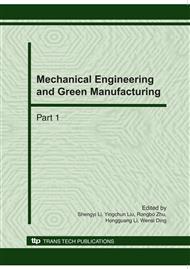p.1070
p.1076
p.1082
p.1088
p.1092
p.1098
p.1104
p.1109
p.1114
Modeling the Horse’s Musculo-Skeletal System: A Step Towards the Design of Bionic Motorcycle Frame
Abstract:
In this paper we develope and analyse a 3D model of horse’s musculo-skeletal system as a bionic inspiration which can lead to the design of a cross-country motorcycle frame. Based on the great running and load carrying ability of the horse we were inspired to observe its biomechanical functions, extract useful principles, and simplify the extracted information for modeling. We represent the horse’s musculo-skeletal system by seven cylindrical beams connected together by hinge joints, and then analyze it using ANSYS software. The analysis results shows that the vibration and stress in the model can be minimize by changing the joints between the beams from rigid to hinge joints under different spring bars’ stiffness. This model can provide useful information to improve the functional characteristics of motorcycle frames.
Info:
Periodical:
Pages:
1092-1097
Citation:
Online since:
October 2010
Authors:
Price:
Сopyright:
© 2010 Trans Tech Publications Ltd. All Rights Reserved
Share:
Citation:



